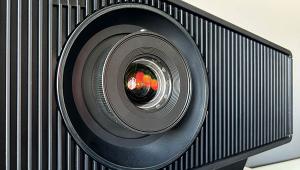Samsung The Premiere 9 4K RGB Laser UST Projector Review
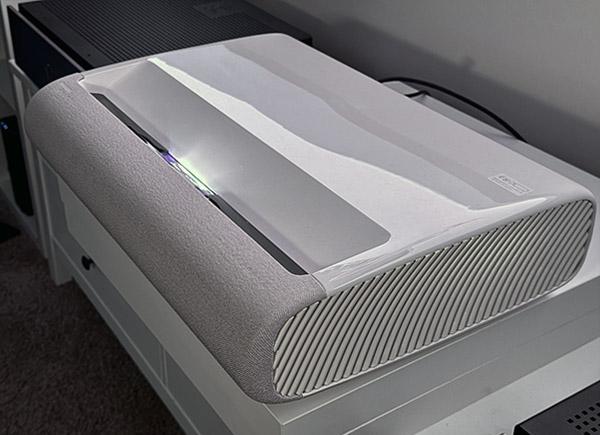
Plus
Sharp 4K resolution
Impressive color gamut
Brightness in ambient light
Easy setup and integration
Powerful built-in sound
Tizen smart features
Minus
Limited native contrast
Best in dim lighting (like all projectors)
Not for hardcore gaming
High price point
THE VERDICT
With just a few minutes setup and when viewed under controlled lighting, The Premiere 9's image is roughly equivalent in appearance to a 120-inch or larger TV.
Samsung's The Premiere 9 arrives at an interesting juncture. The ultra-short throw (UST) projector category, once a scrappy upstart, has matured, along with consumers' understanding of how these devices fit into the AV lifestyle. USTs are no longer just alternatives to traditional projectors, and with 98" TVs now priced similarly, they no longer have a monopoly on the big-screen experience. Evaluating USTs by the same criteria as TVs and home theater projectors often overlooks their unique strengths and can sometimes ignore their limitations.
Features
The new The Premiere 9 is a sophisticated 4K RGB triple-laser UST that feels unmistakably like a Samsung. Its menus, picture processing, and smart OS functionality mirror those of Samsung's current TVs and smart monitors, making it a sibling rather than a distant cousin in the Samsung display family. The Premiere's picture modes are calibrated to deliver a viewing experience consistent with Samsung's TVs and gaming monitors, providing brand loyalists with consistency. Additionally, its smart OS offers more refined and capable streaming than what’s typically found in USTs from most other brands.
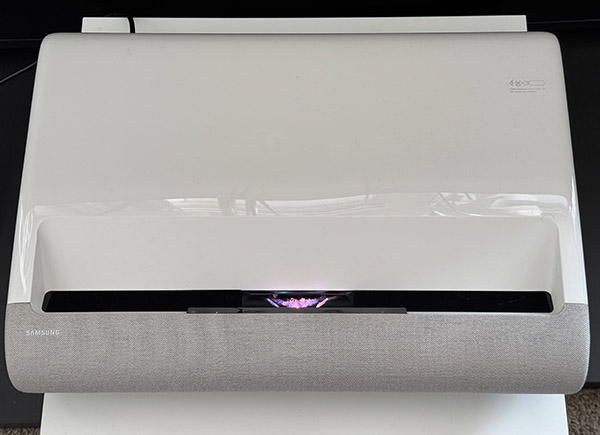
At its core, this projector utilizes a sophisticated triple-laser light source and uses pixel-shift DLP projection technology to output 4K. This 4K resolution is supported by Samsung’s Quantum Processor 4K, which enhances every frame with the precision you'd expect from a high-end Samsung TV. Whether you’re watching a movie, streaming a show, or gaming, the projector’s Quantum HDR and HDR10+ Certified technology ensure that every scene is rendered with high contrast and a rich depth of color.
The throw ratio of just 0.189:1 allows The Premiere 9 to project an expansive 100- to 130-inch screen size from a minimal distance. For a 100-inch image, the projector needs to be placed only 4.5 inches away from the wall, making it ideal for compact spaces where a traditional projector setup might not be feasible. The brightness levels are equally impressive, with rating of 3450 ISO lumens, ensuring that the image remains vibrant even in moderately lit environments. This makes it not only a great choice for dark home theater setups but also for living rooms where ambient light might be a factor.
The Samsung The Premiere 9 comes with three HDMI inputs, all supporting 4K at 60Hz, so you can directly connect multiple devices like streaming boxes, gaming consoles, or Blu-ray players. The projector features eARC, allowing high-quality audio, including Dolby Atmos, to be sent to external sound systems or soundbars with a single cable connection.
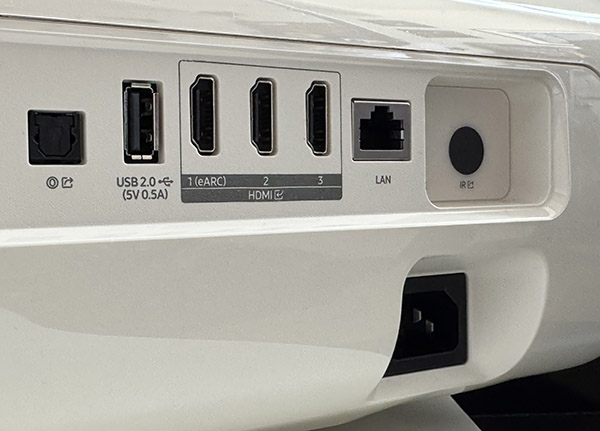
The remote is effectively the same minimalist solar-charging design seen elsewhere in the Samsung TV ecosystem. It has buttons dedicated to Netflix, Samsung TV Plus, Disney+. and Prime Video. It also has the ability to control other devices connected to the projector.
When it comes to audio, The Premiere 9 comes well equipped. It features a 2.2.2 channel speaker system with a total power of 40W, including a 20W woofer that adds depth, it's basically a built-in soundbar. Samsung's Object Tracking Sound (OTS) technology, along with Dolby Atmos support, ensures that the audio is immersive to match the visuals, creating a surround-sound experience that envelops you in the action. Additionally, the projector supports Q-Symphony, allowing it to pair seamlessly with compatible Samsung soundbars to further enhance the audio quality.
The projector is powered by Samsung's Tizen OS, which brings a host of smart features and seamless connectivity. With built-in voice assistants like Alexa, as well as Samsung’s SmartThings Hub, you can control not only the projector but also other smart devices in your home. The inclusion of features like Auto Game Mode (ALLM), Game Motion Plus, and Dynamic Black EQ makes it a versatile option for gamers, although it’s more suited for casual gaming with a 4K 60Hz refresh rate rather than high-frame-rate PC gaming.
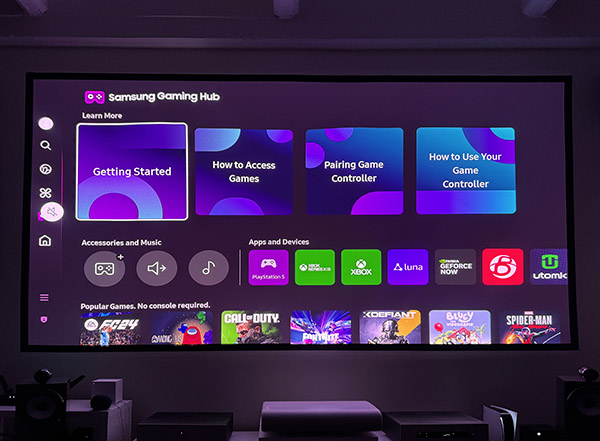
Finally, Samsung has integrated various eco-friendly features into The Premiere 9. The projector includes an Auto Power Saving mode, which intelligently reduces power consumption when the projector is not in use. The robust design of the projector is complemented by a long-lasting laser light source, rated for 20,000 hours of use, ensuring years of entertainment without the need for frequent maintenance.
As you can see, Samsung's feature set is impressively deep, powered by the Tizen OS, which benefits from shared features with the company's TVs, and a unified user interface design. This allows for extensive customization, a rich user experience, and a consistent feel across homes equipped with other Samsung displays. If you've used a Samsung TV before, you'll immediately feel at home with The Premiere's remote and user interface.
While some UST projectors are pushing the boundaries of native contrast in DLP projection, this Samsung model isn’t among them. In real-world settings where lighting can't be fully controlled, extremely high native contrast ratios—essentially, how deep the blacks can get—are often less noticeable. In these environments, brightness tends to be more impactful than black levels.
Setup
This projector features a particularly aggressive throw ratio of 0.189:1, enabling it to sit very close to the wall.
In the past, I've been meticulous about pairing ultra-short throw (UST) projectors with UST-specific screens, typically lenticular ceiling light-rejecting models with a gain of 0.5 to 0.6, often in 100" or 120" diagonal 16:9 sizes. However, for this review, I opted to use the projector with a matte white "painted wall" screen in my living room—the same one I use for long-throw projectors.
This screen measures 159" diagonally and has a 1.0 gain, which compensates for the larger size with its higher brightness versus the dedicated UST screens. I found that the projector had no issue focusing on this larger screen size, with sharpness extending from edge to edge.
In the living room setup, I have a surround-sound system already set up, so for some viewing I used that instead of the built-in sound. And by skipping the physical center channel (using a phantom center instead) I was able to flank the UST with the Primare receiver and amplifier. But this is not a review of that system. It's worth noting that the built-in sound of The Premiere 9 is quite good on its own.
I still keep a 100", 0.6-gain UST screen on hand for reviews, but ever since I got a 98" TV, that size no longer impresses me. What excites me about projectors, especially USTs, is seeing a compelling picture on a screen 120 inches or larger. This provides a truly cinematic experience, beyond what flat-panel displays can currently offer at typical residential viewing distances. You can certainly get a 120-inch screen that remains seamless, which is a valid and, in many cases, the best choice—or at least the best compromise. This option offers wide viewing angles without impacting color; it avoids the drawbacks of Fresnel-type screens, where the main downside is the loss of brightness due to their relatively low 0.5-0.6 gain (Of course, if your projector is bright enough, you can compensate for that).
I also auditioned the Samsung in my bedroom using a 120" Elite Cinewhite screen. I have added black felt to the ceiling to absorb light spill. This solution depends on viewing in the dark for maximum impact.
While an ambient light-rejecting screen generally provides better contrast in most lighting conditions, with a 1.0-gain matte screen, dimming the lights yields a very bright, clean, and color-accurate image. If you want your UST to behave more like a TV in terms of contrast, then a UST-specific screen is the way to go.
Don’t assume you can just grab this projector, point it at any bare wall, and expect everything to look great. Ultra-short throw projectors, by their nature, project at an extreme angle, which can create issues when interacting with a typical wall. For instance, most wall paint has a slight texture, which becomes exaggerated when the light hits from the side or bottom. Walls that appear flat may have subtle waviness or distortion, which becomes obvious with an extreme-angle projection.
While The Premiere's built-in digital keystone correction can make minor adjustments, it can't correct complex distortions and is best avoided. Ideally, you should use a screen. If you're using a wall, ensure it’s flat, smooth, and properly sanded or skim-coated. Remember, there’s no single "correct" way to install a UST projector. It all depends on your intended use and the experience you want to create. For instance, if your primary use is projecting live sports, similar to a sports bar setup, you might consider ceiling-mounting the projector. This eliminates concerns about light reflecting off the ceiling and washing out the image.
Without getting too deep into screen types and installation options, it's worth noting that UST screens are evolving. The latest options, often Fresnel types, aim to offer higher gain while retaining the ambient light-rejecting qualities of popular lenticular screens. They can look very good even under bright lights. However, these come with their own challenges: They are easily damaged, have limited viewing angles, come with size constraints, and higher costs. But the point is UST shoppers have more options than even on how to install and use one.
Performance
As mentioned in the introduction, this UST looks and feels like a true Samsung display, namely its TVs. Which means the Standard picture mode is designed to enhance the image, making it "pop" with a crisp, bright, and well-defined picture—ideal for watching broadcast TV like sports. However, if you prefer a more technically accurate image, the Movie and Filmmaker modes are calibrated to preserve the creative intent of the content.
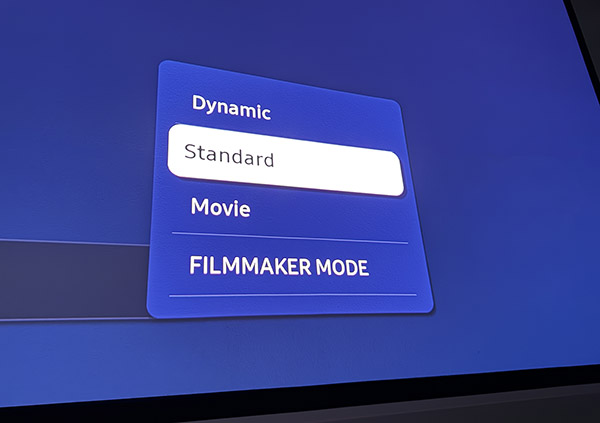
Samsung has done an impressive job tuning this projector to deliver an image in a living room setting that rivals what you might expect from a 150-inch TV, if such a thing existed. During the day, the image may wash out, making it better suited for sports or live TV. But in the evening, the picture quality shines, offering compelling movie viewing and big-screen immersion for casual gaming.
Thanks to its tunability, The Premiere can serve multiple roles: as a home cinema in a dark room, a general TV in controlled lighting, or a giant-screen TV that's perfect for sports, even in relatively bright environments. With 3,450 ISO lumens, it’s a bright projector that easily overcomes moderate ambient light.
What I've noticed with this projector, and others like it, is that native contrast alone doesn't fully capture how a projector handles deep shadows—a crucial aspect that distinguishes a good DLP projector from a mediocre one. The ability to display varying gradations of dark shadows gives a projector its cinematic quality.
This isn’t surprising; in movie theaters—especially those using film or DLP projection, standard for commercial cinema—the native contrast doesn’t approach the levels of an OLED TV or a Christie Eclipse projector. Yet, the image looks great because it's skillfully rendered within the more modest contrast range, and the darkened room maximizes the effect. Samsung provides a Shadow Detail control that lets users adjust this critical parameter.
The key takeaway is the room itself, and the lighting conditions within the room, both play a significant role in a projector's performance, much like it does with a speaker system. To truly benefit from a projector with exceptionally high native contrast, you need a fully light-controlled, blacked-out "bat cave" theater. Even in such an environment, a projector with more modest contrast but exceptional overall quality—like a high-end Barco projector—can still deliver stunning results.
What matters more that black levels alone is how well the projector handles shadow detail within the limited real-world contrast it can offer. This ability to render shadow distinct shadow detail is a defining factor in the overall image quality.
One of the key strengths of this projector is its exceptionally wide color gamut, a hallmark of triple-laser RGB UST projectors. These are among the few consumer displays that are reaching—or even exceeding—the REC.2020 standard, which surpasses the DCI-P3 color space. REC.2020 essentially encompasses the full range of color saturation that the human eye can perceive.
The main viewing experience I enjoyed with this UST, thanks to lucky timing, was the 2024 Paris Olympics. What a treat it was! The spectacle of watching so many different sports presented in such a dramatic fashion was unlike any Olympics I've seen before. The combination of DLP's excellent motion handling and Samsung's processing delivered detailed resolution with seamlessly smooth motion. Track and Field events were a joy to watch—The Premiere made it easy to catch even the smallest details during the lightning-fast action.
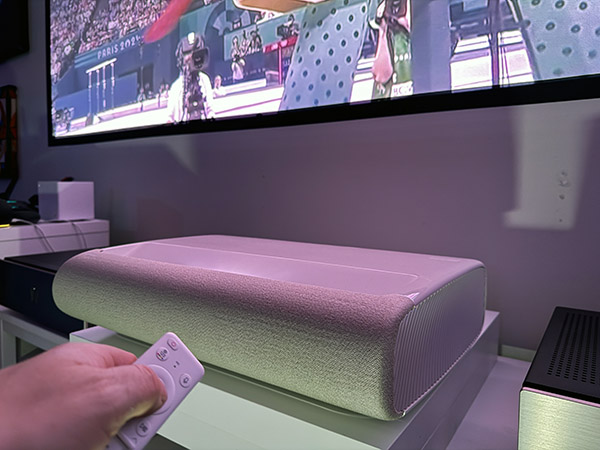
Watching gymnastics, especially Simone Biles' incredible comeback, was a highlight. The ability to follow her unprecedentedly complex moves in such clarity is something many TVs struggle with, but here, you truly get your money's worth. The combination of a big picture and clear presentation made it possible to witness greatness in real-time.
I've never really had the need or desire to use the Multi View feature before. I can see how it might be useful for sports betting enthusiasts or news junkies, but it’s not something I typically seek out—except during the Olympics. In that context, the feature's usefulness became obvious. Suddenly, the motivation to watch multiple events at once was there, and while not a new feature, its appeal shines on a giant screen with sharp, smoothly rendered video.
Since much of the broadcast was in 1080p rather than 4K, there was no loss of detail in multi-view mode. In fact, you could argue there’s a gain in perceived detail.
While the Olympics dominated my viewing, I also caught a few good movies during the review period, including Bad Boys Ride or Die and Furiosa: A Mad Max Saga. Both are packed with action, vibrant imagery, and intense motion—perfect for putting the projector through its paces. The proof is in the pudding, I got lost in the movies and was not distracted by any aspect of the presentation.
The most important performance aspect to highlight is how the projector handles movies when in Movie and Filmmaker modes. In these modes, it forgoes motion interpolation, delivering a natural cadence with a genuinely filmic quality. This results in a cinematic look that, in my opinion, this projector handles better than most TVs, thanks to DLP's superior motion rendering.
Another thing to note is that the cinematic movie modes as not as bright as the Standard mode, nor do they need to be. When watching a movie, you definitely want to dim the lights. But inside the projector is an interesting setting: Peak Brightness. When enabled, the brightest highlights are rendered even brighter, but with less color accuracy. But the difference in color is negligible, and you do get a bump out of it regardless of what mode you are in. But for those who sleep better at night when their delta-E is as low as possible, turning Peak Brightness off is the path to nicer looking Calman charts.
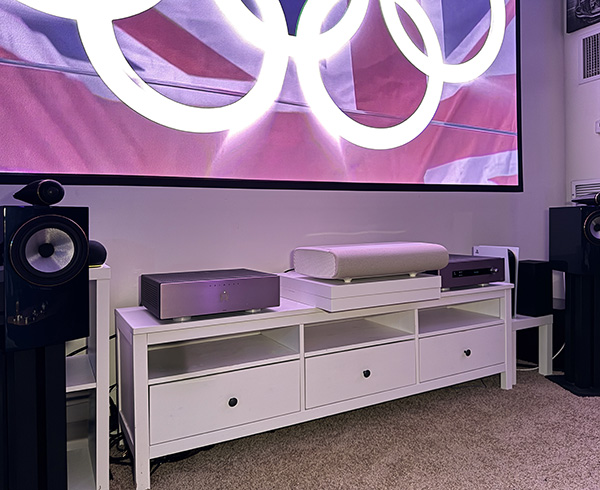
As noted earlier, Whether it's TV, gaming, or movies, once ambient light is introduced, the advantage of deep black levels in a projector is largely lost. Interestingly, the same principle applies when it comes to ambient light and color saturation. To get the maximum pop and impact from this projector, the usual rules for any projector still hold: dim the lights, or better yet, turn them off. This is the one unavoidable similarity USTs share with all other types of projectors.
Conclusion
I’ve closely followed Samsung's return to projection, and what stands out in its recent models is how the company has streamlined the experience. These projectors are no longer oddities that behave differently; instead, they deliver a consistent experience, allowing you to confidently refer to them as Samsung displays.
Here’s the thing: If you shop for AV gear based purely on specs, more power to you. You're likely aware that ergonomics and industrial design are not the same as measured performance. My perspective in this review is that Samsung has optimized this projector well beyond what even an enthusiast consumer might expect for performance, and wrapped it in a gorgeous industrial design. It's the complete package.
Anyone considering an ultra-short-throw projector should understand what they’re getting into first, because $5K is a lot of money and can buy a very nice 85- or even 98-inch TV for that amount these days.
But if your goal isn’t to replace a home theater projector, and TVs are too small for you, and you know you'd enjoy the benefits of a versatile, compact device that puts out a gigantic picture, what's not to love about this Samsung? Right out of the box, it delivers that hyper-real, Standard Mode TV image—a hallmark of Samsung, the world’s leading TV maker for years. Whether reviewers like it or not, consumers clearly respond to this visual formula.
At the same time, the tuning of the Movie and Filmmaker Modes is impressive. You don’t need to worry about professional calibration; the tools provided allow a video enthusiast to easily tweak and optimize this projector for their room, viewing habits, and content. With a good test disc featuring reference imagery, like the Spears and Munsil UHD Benchmark, you can fine-tune the settings without needing specialized knowledge or equipment.
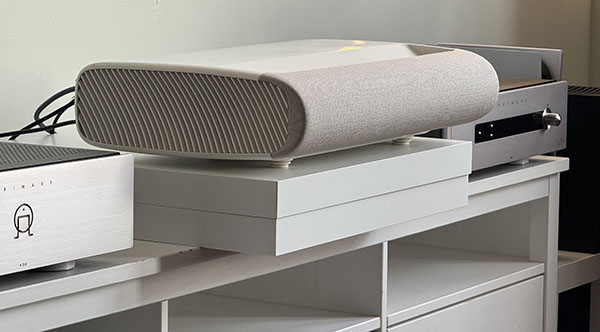
Other sites that focus on detailed measurements will surely review this UST and verify (or challenge) the manufacturer's claims about gamut coverage and contrast. Projector shootouts will follow, winners will be named. However, the bottom line is that it's a well designed triple-laser DLP UST with good specs, competing in an increasingly crowded market. What sets this Samsung apart isn’t a few hundred lumens or minor differences in DCI/P3 gamut coverage, but rather its picture processing and user experience expertise that the world's number one TV maker brings to the table.
My subjective impression is that Samsung has significantly improved the perceptual picture quality of this triple-laser RGB unit by addressing the color misalignment issues that plagued earlier generations of RGB laser USTs, regardless of the manufacturer. The image The Premiere 9 puts out is clean, sharp, color accurate, and visually compelling.
Specs
- RESOLUTION: 3840 x 2160 (4K)
- REFRESH RATE: 60Hz
- LIGHT SOURCE TYPE: Triple Laser
- LIGHT SOURCE LIFE: 20,000 hours
- THROW RATIO: 0.189:1
- SCREEN SIZE: 100 to 130 inches
- BRIGHTNESS: 3450 ISO Lumens
- 2,000,000:1 (Dynamic)
- HDR SUPPORT: Quantum HDR, HDR10+, HLG
- AUDIO OUTPUT: 40W (2.2.2 channel system)
- SOUND FEATURES: Dolby Atmos, Object Tracking Sound (OTS), Q-Symphony
- OPERATING SYSTEM: Tizen OS
- VOICE ASSISTANTS: Alexa, Bixby
- HDMI INPUTS: 3 (4K 60Hz, eARC support)
- CONNECTIVITY: Wi-Fi 5, Bluetooth 5.2, Ethernet
- DIMENSIONS: 550 x 141.3 x 384.1 mm (with stand)
- WEIGHT: 11.6 kg (with stand)
- POWER CONSUMPTION: 410W (Max), 0.5W (Standby)




